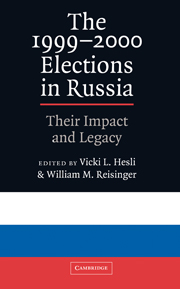Book contents
- Frontmatter
- Contents
- Contributors
- Acknowledgment
- SECTION I INTRODUCTION
- SECTION II PARTIES IN THE ELECTORATE
- SECTION III THE ROLE OF REGIONAL POWER
- 6 Elections and National Integration in Russia
- 7 The 1999 Duma Election in Russia: A Step Toward Democracy or the Elites' Game?
- SECTION IV PARTIES AND INSTITUTIONS
- SECTION V CONCLUSION
- Bibliography
- Index
6 - Elections and National Integration in Russia
Published online by Cambridge University Press: 23 October 2009
- Frontmatter
- Contents
- Contributors
- Acknowledgment
- SECTION I INTRODUCTION
- SECTION II PARTIES IN THE ELECTORATE
- SECTION III THE ROLE OF REGIONAL POWER
- 6 Elections and National Integration in Russia
- 7 The 1999 Duma Election in Russia: A Step Toward Democracy or the Elites' Game?
- SECTION IV PARTIES AND INSTITUTIONS
- SECTION V CONCLUSION
- Bibliography
- Index
Summary
This chapter focuses on the spatial aspect of Russian electoral democratization. The concept of space will be interpreted broadly not only to encompass the territorial aspect but also to reflect on the way that political space is structured and represented. The central argument will be that electoralism in Russia has become one of the main devices forging a political community, and is thus at the heart of the nation-building enterprise in the new post-Communist state. This electoralism, however, is flawed and fractured, and the differentiated application of electoralism fragments the nascent political community.
In this context, this chapter will focus on three central issues. First, the ethical basis for the federal separation of authority has been undermined by spontaneous processes of segmented regional devolution (sometimes called “asymmetrical federalism,” although some of what goes under this term has little to do with federalism as it is usually understood). This segmented regionalism undermined the development of a national party system, something that the authorities under President Vladimir Putin sought to overcome.
Second, and related to the first, the presidential regime was much weakened in the late Yeltsin years, and the regional executives sought to fill the vacuum of central authority. The main drama of the 1999–2000 electoral cycle focused on the struggle between the center and the regions, a struggle that was over power but also about the nature of Russian federalism and of the national political community.
- Type
- Chapter
- Information
- The 1999–2000 Elections in RussiaTheir Impact and Legacy, pp. 121 - 141Publisher: Cambridge University PressPrint publication year: 2003
- 3
- Cited by



